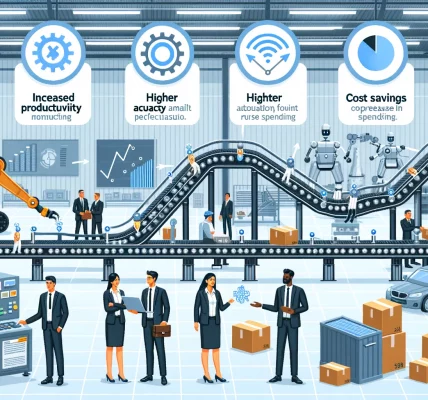Emerging Technologies Shaping Content Marketing
Tech Futures Transforming Storytelling
The future of content marketing has arrived, and it’s as thrilling as the latest sci-fi blockbuster. Emerging technologies are flipping the script on how we create and deliver stories. At the forefront? Think about tools like augmented reality (AR) that literally paint your words into your audience’s world or AI-powered chatbots that turn static articles into dynamic conversations.
It’s not just about gadgets and gizmos—it’s about connection. Imagine scrolling through a blog post about upcoming smartphone launches, but instead of just skimming text, you pop on AR glasses to see the sleek new designs hovering in your living room. Magic? No, just 2025’s innovation.
- Natural language processing (NLP): This tech break lets blogs write and “speak” with human-like authenticity (not the clunky auto-generated stuff we’ve all cringed at before).
- Blockchain in content verification: Yes, blockchain isn’t just for crypto anymore. It’s revolutionizing authenticity and copyright protection while giving creators the recognition they deserve.
These aren’t distant dreams—they’re today’s reality reshaping tomorrow’s content game. And trust me, if your blog doesn’t embrace them soon, it’ll risk reading like yesterday’s newspaper.
Personalization and AI-Driven Content Strategies

Turning Generic Content Into Tailor-Made Experiences
Imagine landing on a blog that feels like it was written just for you—as if the writer knew exactly what you were looking for, what questions you might have, and even your favorite way to consume content. That’s the magic of AI-driven personalization. It’s not sci-fi; it’s happening right now, and in 2025, it’s going to be the gold standard for tech blogs.
By analyzing everything from reader behavior to search intent, AI tools can craft customized experiences that feel less like scrolling through endless pages and more like having a one-on-one conversation. For example, if your audience is into software engineering, AI might recommend deep-dive articles about Kubernetes or Python tricks, while a different reader might see infographics explaining cloud computing.
- Think Netflix recommendations but applied to your blog content.
- Chatbots that not only answer FAQs but guide readers to their ideal article based on mood or need.
With this level of precision, tech blogs will evolve from mere information hubs into personal tutors, ready to serve up exactly what’s needed the moment it’s needed.
Data-Driven, Heart-Led Storytelling
You might think data-driven storytelling sounds cold, but here’s the kicker: it’s anything but. Tools powered by AI not only crunch numbers but also help uncover trends, spikes in interest, or unsolved pain points within your niche. The result? Stories that resonate on a deeply human level because they’re rooted in what people actually care about.
Take this example: let’s say AI identifies an uptick in searches for cybersecurity for small businesses. Instead of overwhelming your readers with industry jargon, why not spin a narrative about a startup owner dodging a ransomware attack due to smart security practices? Thanks to AI, you’re not guessing what your audience needs—you’re hitting the bullseye every time.
Oh, and don’t forget: those stats you used to dread pulling? Now AI can deliver them with insights on what’s worth mentioning and what’s just fluff. Combine the precision of AI insights with storytelling that hits people where it counts, and your tech blog isn’t just a source—it’s a destination.
The Rising Importance of Interactive and Visual Content

Why Tech Readers Crave Immersive Experiences
Imagine scrolling through a blog and instead of plain text, you’re greeted with an interactive graph predicting the next big AI breakthrough or a clickable 3D model of the latest wearable tech. The days of passive consumption are over—*engagement* is the name of the game. Tech-savvy audiences are restless and expect more than static paragraphs.
Here’s why interactive and visual content is stealing the spotlight:
- Better retention: A carousel of infographics or a quick explainer video sticks far longer in the memory than a wall of text.
- Higher engagement: Polls, quizzes, and virtual walkthroughs invite readers to participate, turning them from viewers into active contributors.
- Shareability: A visually stunning animation or clever meme practically begs to be shared across social platforms.
Tools That Make It Easier Than Ever
Gone are the days when creating visuals meant hiring a full production team. With tools like Canva, Lumen5, and interactive platforms like Eko, you’re just a few clicks away from content that dazzles. Picture this: your blog post on cloud computing could include an embedded video with clickable branches, letting readers choose what aspect to explore next. It’s not just content—it’s an *experience*.
Inject your posts with life, and watch your audience lean forward, click, and share!
SEO Developments and the Role of Voice Search

Voice Search: The Revolution That Speaks to Us
Imagine this: you’re in the kitchen, covered in flour, juggling a whisk and a recipe with no hands free. What do you do? You shout at your trusty voice assistant for help. This is exactly how millions are interacting with search engines today. And here’s the kicker—voice search queries are transforming the entire SEO landscape.
Voice search isn’t just making life easier; it’s rewriting the rules for how we write. People don’t talk like they type. Instead of “best laptops 2025,” they’ll say something like, “What’s the best laptop to buy in 2025 for remote work?” See the difference? It’s all about conversational language—and that’s where your content needs to shine.
- Focus on long-tail keywords and natural phrasing.
- Make your content answer specific, real-life questions your audience asks.
- Optimize for featured snippets—voice assistants love pulling from them!
The Tech Blog Twist: Staying Ahead of Voice Trends
For tech blogs especially, voice-friendly SEO is non-negotiable. Innovations like AI-driven algorithms now prioritize local relevance and succinct answers. Think about how often people ask, “What’s the latest gadget released by Apple?”. If your blog doesn’t address these queries clearly and concisely, you’re letting competitors steal the show.
So, make it personal. Write like you’re explaining to a friend. Include stats, but toss in some personality. And remember: in the world of voice search, brevity is brilliance.
Sustainability and Ethical Content Practices

Why Tech Blogs Need a “Green” Touch
The future of content marketing isn’t just about *what* you say—it’s about how ethically and sustainably you say it. In 2025, readers will no longer tolerate content that churns out clicks while ignoring the environmental and societal cost of its creation. Imagine writing a tech blog post powered by clean energy instead of energy-guzzling servers or sourcing your data from a company that pays fair wages worldwide. Feels better, right?
When you embrace sustainable and ethical practices, your content resonates deeper. It’s like planting seeds of trust with your audience. Think:
- Partnering with platforms using carbon-neutral hosting.
- Citing studies from companies committed to diversity and transparency.
By aligning these elements with your values, you don’t just inform—*you inspire*.
Content That Reflects Real Values
Here’s a truth bomb: audiences can smell insincerity from a mile away. Flaunting “sustainability” as a buzzword while your practices say otherwise? That won’t fly. Ethical marketing involves decisions like avoiding exploitative labor or ensuring your AI tools are trained on consent-only datasets. Yes, even your algorithms need a moral compass!
At the core, it’s simple: let your actions amplify your words. After all, in 2025, sustainability isn’t extra credit—it’s the baseline.












